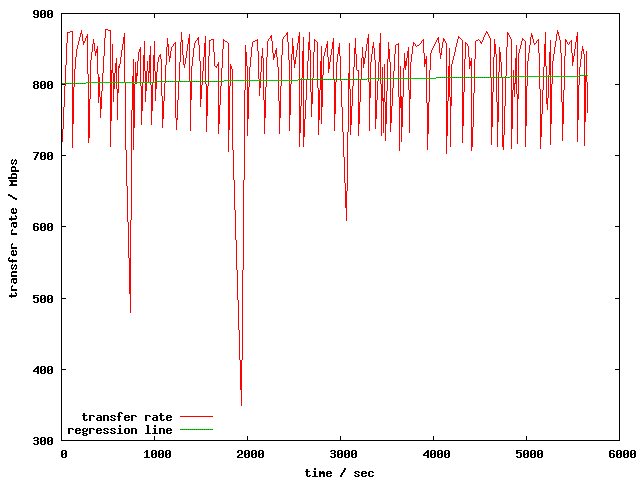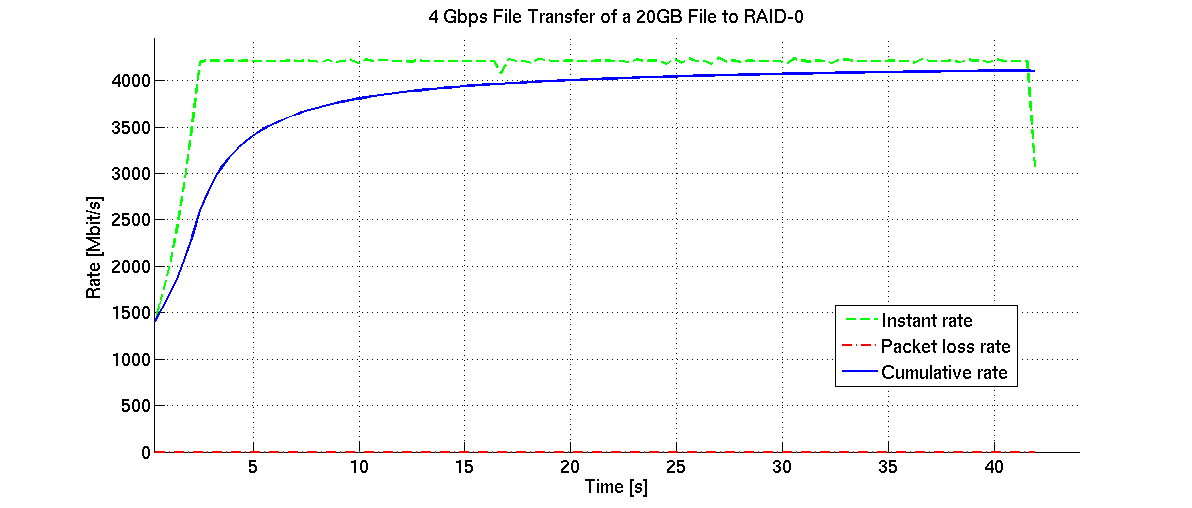Tsunami UDP Protocol
Tsunami UDP Protocol: A fast user-space file transfer protocol that uses TCP control and UDP data for transfer over very high speed long distance networks (≥ 1 Gbps and even 10 GE), designed to provide more throughput than possible with TCP over the same networks. The project is based on original Indiana University 2002 Tsunami source code, but has been significantly improved and extended. As such, large portions of the program today are courtesy by Aalto University Metsähovi Radio Observatory.
Includes FTP-like client and server command line applications for normal file transfers. It has additionally been extended for high rate real-time data streaming in eVLBI radio astronomy and geodesy (VSIB, PCEVN DAQ). Licensed under the original IU open source license.
Updates
Version 1.1 cvsbuild 40 has automatic achieved rate memorization and several changes for smoother transfers. Beginning with version 1.1 cvsbuild 29 Tsunami now (09/2007) supports transfers between different-endian machines. Listing shared files with dir is supported since cvsbuild 27. Mac OS X / Darwin works beginning with cvsuild 36. For more changes, see the changelog.
The previous CVS update was on 22 December 2009.
The code was migrated from CVS to Git in July 2019.
Background
The original early Tsunami UDP transfer protocol developed and released to the public in 2002 by Mark Meiss et al. at the Pervasive Technology Labs at Indiana University (IU) can still be found at http://anml.iu.edu/research.shtml?prim=lab_research.
This project is a derived work - if not a complete rewrite - of the original IU source code. The new Tsunami includes a large number of bug fixes, improvements and new features. File releases in the form of compressed source code archives can be downloaded from the project page at http://sourceforge.net/projects/tsunami-udp, but I recommend you'd use the CVS version.
Source code access
Currently no binaries are distributed, only the source code is available and should be compiled on the target system. It should compile fine on all POSIX systems and on GNU/Linux, no special libraries or toolkits are required. Microsoft Windows and Vista are not supported (XP offers an optional POSIX layer, but some parts of Tsunami code would have to be slightly adapted neverheless, and unfortunately in Vista Microsoft has abandoned POSIX altogether).
Any current version of source code pulled from Git master will compile and work, and has been tested somewhat extensively. The Git version is likely to contain new features. There are no guarantees any new features are going to work correctly with older versions of the Tsunami client/server. Nevertheless, in the basic features, Tsunami generally is backwards compatible.
If you want to get a non-changing stable release version, you may check out the following Git tags (former CVS tags):
v10_RTM_protorev20061025 (v1.0 released 31. Nov 2006), v11_build11_protorev20061025 (v1.1 build 11 released
5. Jan 2007), v11_build16_protorev20061025 (v1.1 build 16 released 24. May 2007),
v11_build29_protorev20061025 (v1.1 build 29 released 29. Aug 2007), v11_build36_protorev20061025
(v1.1 build 36 released 26. May 2008). There are other tags, please see ViewCV. Alternatively, some probably
significantly less up to date source code .tar.gz files can be downloaded from file releases.
| Source code and compile cheatsheet | |
|---|---|
|
git clone https://git.code.sf.net/p/tsunami-udp/code_git tsunami-udp-code_git (and for a particular tag then e.g. 'git checkout v11_build29_protorev20061025') |
|
| https://sourceforge.net/p/tsunami-udp/code_git/ci/master/tree/tsunami-udp/ | |
| https://sourceforge.net/p/tsunami-udp/code_git/ci/master/tree/docs/ | |
| COMPILING.txt | |
| ChangeLog | |
| Users Guide, Troubleshooting and Realtime | |
| USAGE.txt including Troubleshooting | |
| howTsunamiWorks.txt | |
09Nov07: Those with a sluggish Petabit/sec network connection ;) can try the protocol version 1.2 in CVS branch
protocol_v12_branch. Still unstable and experimental. The set rate value in v1.1 has only 32 bits and
thus limits the user-settable rate to 4 Gbps. Not so in v1.2. Checkout like above but with tag
Hardware requirements
Here is a short summary of vague hardware requirements. It's nothing fancy apart from the RAID-0 disk requirement.- Consumer PC motherboards are highly suitable
- Disk: to achieve high transfer rates, disk I/O must be adequately fast. It is essential to use fast RAID, e.g. RAID0 with a large
chunk size setting such as 512 kB. Linux software RAID using mdadm performs well enough - typical performance with 4
SATA disks is around 1.8 Gbit/s (05/2007). You can check your disk throughput with
hdparm -t /dev/md0 , it should be 100 MB/s or better. - CPU: the CPU should be Pentium4 or better. Consumer multi-core CPUs are quite nice.
- RAM: the client program requires up to 128MB of free memory for internal buffers, and swapping has to be avoided at all cost, thus at least 512MB of RAM is strongly recommended.
- NIC: any motherboard 1 Gbit/s Ethernet is usually sufficiently fast. Server grade NICs are completely unnecessary. Usual 10 Gbit/s PCIe NICs can be used, too.
- Network: the network connection should be faster than the typical home broadband connection, for example a 630 Mbit/s or 1/10/40/100 Gbit/s fibre connection. Jumbo frames are not strictly required, but they can boost performance if you want to use rates higher than 5 Gbit/s. Lightpaths, guaranteed bandwidth QoS services etc are a matter of debate, my take is to only consider them after (if ever) network people start complaining about your traffic (and then first try the 'you sold us a 10 Gbit/s connection so we darn well are going to transfer at 10 Gbit/s' route ;-).
Typical transfer rate examples
Below are a few examples of transfer rates that Tsunami can achieve over the Internet. On a local LAN, for disk-to-disk transfers rates near the limit of the PC NIC or on-board LAN are easily achieved, which is usually around 940 Mbps for 1G LAN. This is provided that the disk system in both PCs is adequately fast, e.g. simple software RAID-0 with three or four SATA disks (no RAID controller necessary).
 Figure 1 - international transfer over the Internet, averaging 800 Mbit/second |
Figure 1 shows a throughput plot of a disk-to-disk transfer where several multi-gigabyte files are transferred one after another from Helsinki, Finland to Bonn, Germany. Both PCs have a fast (>1 Gbps capable) RAID-0. Linux software RAID-0 with 4 SATA disks on the sending side, with a Dell Optiplex GX620 cheap PC. SATA RAID card at the receiving side. The server side had 10 Gbps fibre to the Finnish 'Funet' GEANT2 NREN, the client side had a shared fibre to the Viola GEANT2 NREN with ~1 Gbps allocated capacity.
 Figure 2 - a short 20GB file transferred with Tsunami v1.2 over local 10 Gbps LAN at Metsähovi. |
Figure 2 shows a Tsunami v1.2 test transfer on the local 10G LAN at Metsähovi. RAID-0 were built with Samsung SpinPoint F1 disks on dual and quad-core consumer computer systems with Chelsio 10G cards connected via a HP6400cl switch. The transfer rate is limited to 4.3 Gbps by disk I/O. With diskless transfer a rate of 7 Gbps could be achieved.
